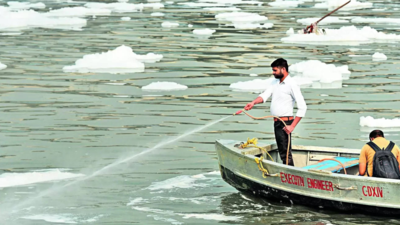- News
- City News
- delhi News
- High ammonia levels continue to plague Yamuna in Delhi
Trending
This story is from December 27, 2023
High ammonia levels continue to plague Yamuna in Delhi
The pollution levels in the Yamuna river continue to increase, affecting water production at the Wazirabad treatment plant. The ammonia levels have reached 2.3ppm, causing a 40% reduction in water production. The Delhi Jal Board (DJB) has sent a letter to the Haryana irrigation department requesting them to stop the sources of pollution. The DJB is responsible for supplying potable water in Delhi and relies on raw water from the Yamuna. The Wazirabad treatment plant needs an upgrade to prevent production slowdowns during high ammonia levels.

For the past two days, pollution levels have been increasing in the Yamuna
NEW DELHI: The ammonia levels in the Yamuna continue to fluctuate and the water production is affected at the Wazirabad treatment plant by 40%, the Delhi Jal Board (DJB) stated on Tuesday.
"The ammonia in the river has reached the level of 2.3ppm, which is quite high. As per the survey teams of DJB, the pollution in the river continues to stay high and the water supply is likely to be affected," said a senior official.
For the past two days, the pollution levels have been increasing in the Yamuna. "It is expected that by Wednesday afternoon, the ammonia in the river water may reduce and the situation may improve," said an official.
According to the evening update of DJB, the Wazirabad water treatment plant (WTP) was treating 89 million gallons per day against the normal production of 135MGD. The production at the Chandrawal WTP has also been reduced, and till the afternoon, the production was down by 25%.
According to officials, a letter has been sent to the Haryana irrigation department pointing out that the sources of pollution in the river is inside the state's geographical territory and that it be stopped.
DJB is responsible to supply potable water in Delhi, for which it is dependent on the supply of raw water through drains in the Yamuna that passes through Haryana before entering the city.
The WTPs in Delhi are forced to shut down when the ammonia levels exceed their capacity of 1ppm.
"The Wazirabad WTP is an old plant and we need to upgrade its chlorination process so that the water production retardation (slowdown) does not occur every time the ammonia levels increase in the river," said a DJB source.
"The ammonia in the river has reached the level of 2.3ppm, which is quite high. As per the survey teams of DJB, the pollution in the river continues to stay high and the water supply is likely to be affected," said a senior official.
For the past two days, the pollution levels have been increasing in the Yamuna. "It is expected that by Wednesday afternoon, the ammonia in the river water may reduce and the situation may improve," said an official.
According to the evening update of DJB, the Wazirabad water treatment plant (WTP) was treating 89 million gallons per day against the normal production of 135MGD. The production at the Chandrawal WTP has also been reduced, and till the afternoon, the production was down by 25%.
The crisis has affected the supply at several VIP areas of NDMC, Cantonment and south Delhi like Greater Kailash, Kalkaji, South Extension and Moolchand.
According to officials, a letter has been sent to the Haryana irrigation department pointing out that the sources of pollution in the river is inside the state's geographical territory and that it be stopped.
DJB is responsible to supply potable water in Delhi, for which it is dependent on the supply of raw water through drains in the Yamuna that passes through Haryana before entering the city.
The WTPs in Delhi are forced to shut down when the ammonia levels exceed their capacity of 1ppm.
"The Wazirabad WTP is an old plant and we need to upgrade its chlorination process so that the water production retardation (slowdown) does not occur every time the ammonia levels increase in the river," said a DJB source.
End of Article
FOLLOW US ON SOCIAL MEDIA










